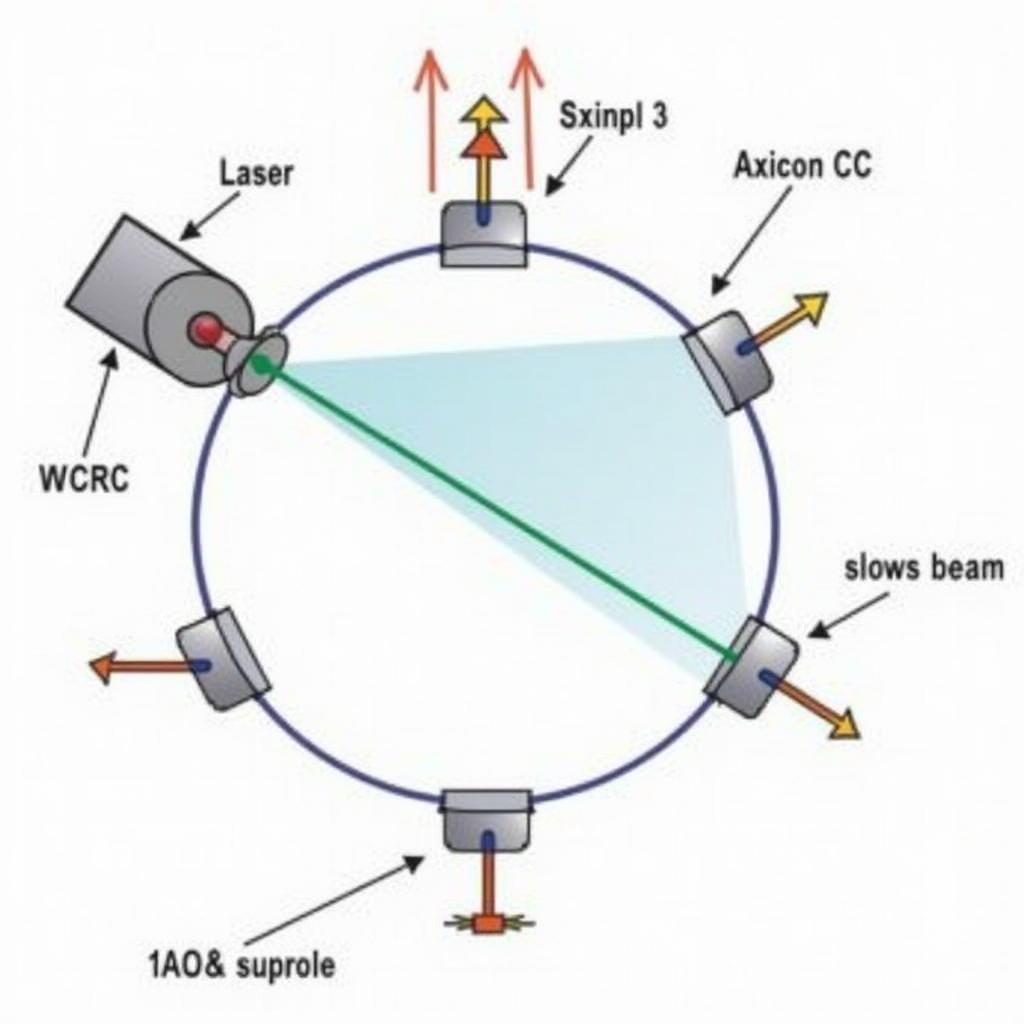Circular Lasers, with their unique beam profile, are revolutionizing various fields, from manufacturing and medicine to research and entertainment. Their ability to produce a perfect circle of light opens up a world of possibilities for precise cutting, marking, alignment, and even creating stunning visual effects. This article dives deep into the world of circular lasers, exploring their functionality, applications, and the science behind their remarkable precision.
Understanding Circular Laser Technology
Circular lasers differ from traditional lasers that emit a focused point or a linear beam. Instead, they generate a ring-shaped beam, providing a uniform distribution of light energy along the circumference. This unique characteristic is achieved through various optical elements and techniques, including diffractive optical elements (DOEs), axicons, and spatial light modulators. These components manipulate the laser beam, shaping it into the desired circular profile. The precise control over the diameter and intensity of the circular beam makes these lasers highly versatile and adaptable for diverse applications.
Applications of Circular Lasers in Various Industries
The versatility of circular lasers makes them invaluable across a wide range of industries. In manufacturing, they are employed for precise cutting and marking of circular shapes on various materials, including metals, plastics, and wood. Their ability to create clean, consistent cuts with minimal heat affected zones makes them ideal for delicate and intricate work.
In the medical field, circular lasers are utilized in ophthalmology for procedures like corneal surgery and retinal treatments. The precise diameter of the laser beam allows surgeons to target specific areas with high accuracy, minimizing damage to surrounding tissues.
Furthermore, circular lasers find applications in research and development, where they are used in optical trapping, microscopy, and spectroscopy. Their ability to create a uniform ring of light enables precise manipulation of microscopic particles and facilitates high-resolution imaging. They are also increasingly used in entertainment and lighting applications, producing captivating visual effects for stage shows, concerts, and art installations.
How Does a Circular Laser Work?
The generation of a circular laser beam involves manipulating the output of a standard laser source using specialized optical elements. One common method employs a DOE, which is a transparent element with a microscopic surface pattern designed to diffract the incoming laser light into the desired circular shape. Another approach uses an axicon, a conical lens that generates a non-diffracting Bessel beam which, when properly focused, produces a ring-shaped intensity profile.
 Nguyên lý hoạt động của Circular Laser
Nguyên lý hoạt động của Circular Laser
Spatial light modulators offer a dynamic way to create circular beams by modulating the amplitude and phase of the laser light. This method allows for precise control over the beam characteristics, including diameter, intensity, and even the ability to create complex shapes beyond simple circles. The choice of method depends on the specific application and desired beam properties.
Benefits of Using Circular Lasers
Circular lasers offer a number of advantages compared to traditional laser systems. Their uniform circular beam profile ensures consistent energy distribution, leading to improved precision and reduced processing time in various applications. The ability to precisely control the beam diameter allows for highly targeted and localized treatments in medical procedures. Moreover, circular lasers often require less power than traditional lasers for achieving the same effect, resulting in higher energy efficiency and reduced operating costs. Their unique properties make them a powerful tool in diverse fields, driving innovation and enabling new possibilities.
Circular Laser vs. Traditional Lasers: A Comparison
While traditional lasers excel in applications requiring a focused point or linear beam, circular lasers offer distinct advantages in scenarios where a uniform ring of light is needed. For instance, in laser cutting, a circular laser can cut a perfect circle in a single pass, whereas a traditional laser would require multiple passes or complex movements. This not only improves efficiency but also reduces the risk of errors and inconsistencies.
 So sánh Circular Laser và Laser truyền thống
So sánh Circular Laser và Laser truyền thống
Conclusion
Circular lasers represent a significant advancement in laser technology, offering a unique and powerful tool for various applications. Their precision, versatility, and efficiency make them a valuable asset in fields ranging from manufacturing and medicine to research and entertainment. As technology continues to evolve, we can expect to see even more innovative applications of circular lasers, further expanding their impact on our world. For all your circular laser needs, don’t hesitate to contact us.
FAQ
- What are the main applications of circular lasers?
- How does a DOE create a circular laser beam?
- What are the advantages of using a circular laser for cutting?
- How are circular lasers used in medical procedures?
- What is the difference between a circular laser and a traditional laser?
- How can I choose the right circular laser for my application?
- Where can I find more information on circular laser technology?
Mô tả các tình huống thường gặp câu hỏi.
Khách hàng thường hỏi về kích thước, độ chính xác và ứng dụng của circular laser trong lĩnh vực cụ thể của họ. Ví dụ, trong gia công kim loại, khách hàng quan tâm đến khả năng cắt các vật liệu có độ dày khác nhau. Trong y tế, câu hỏi thường tập trung vào độ an toàn và hiệu quả của circular laser trong các thủ thuật.
Gợi ý các câu hỏi khác, bài viết khác có trong web.
- Các loại laser khác có sẵn trên thị trường là gì?
- Công nghệ laser mới nhất là gì?
- Làm thế nào để bảo trì laser đúng cách?